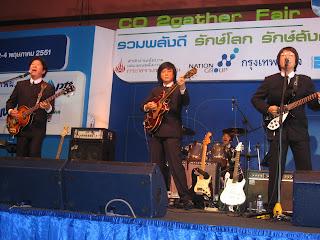OUTSIDE BANGKOK: VISITING THE HILLTRIBES OF NORTHERN THAILAND - AM I AN IRRESPONSIBLE TOURIST?Since we were in Northern Thailand, I felt it was important to see some of the indigenous people of the region, and there are certainly opportunities to do just that, but afterwards I had rather mixed feelings about the whole experience.
What I really wanted to check out were the famous "Long Neck" women of the Karen tribe. I think everyone has seen pictures of these ladies in publications like
National Geographic or on the Discovery Channel, but how many people can actually say they saw them in person? To me that chance was too good to pass up, despite the protests from my wife who had read that the villages are nothing more than tourist traps, these people are basically exploited, treated like sideshow attractions and held against their will. I'm not sure how much of this is true, but after the visit I feel it's probably a strong possibility.
The day before, we visited the Hilltribe Museum and Education Center in downtown Chiang Rai (no photos were allowed) and they also claim that everything my wife was saying was correct and one could learn more there than if they actually visited the villages. Still, I was determined to see for myself...

We arrived at the village and paid our 300 baht (around $10) apiece to enter. The first thing that is unusual about the village is that it gathers several hilltribes together. I don't think these people really live like this. The first woman we saw was from the Palong tribe, famous for their large earrings.

The Akha tribe wears distinctive headdresses and clothing. They originate from China and throughout history have worked in rice fields. The houses they live in are on situated on stilts.



The Lu Mien-Yao tribe also hails from China (Tibet), but have immigrated to places like Thailand, Laos and Vietnam. They have their own unique clothing and headdresses that distinguish them from the Akha tribe.


The Lahu-Muser tribe are known to be experts in herbal medicine as well as hunting and trapping. When we visited them, they treated us to an ethnic dance and music performance.

The Karen tribe comes from Myanmar (originally known as Burma) and their distinguishing characteristic is only far too obvious. I'm not sure what the reason for their neck rings are, but the handout at the village claims they help the women maintain individual and tribal identity while at the same time protecting them from tiger bites. They also wear the rings around their wrists and ankles and the whole getup has to be terribly uncomfortable for them.

The women start to wear the rings at an early age (and many youngsters at the village were already sporting them). From what I've read, the practice does not actually stretch their necks, but rather collapses their shoulders resulting in disfigurement. It's an odd practice, that's for sure.









The rings themselves are quite heavy. As you can see, this one weighs about 5.5 kilos, which is just over 12 pounds. I can't imagine how that must feel.

Many of the women in the camp smiled for photos, but most seemed bored and apathetic. Perhaps they are tired of tourists and being asked to pose all the time and maybe they are being held their against their will, and if they are, why isn't anyone in the Thai government doing anything about it? And that begs the question, am I an irresponsible tourist for wanting to visit this village?
It can be argued that our visit didn't help exploit the situation any more than the bus loads of tourists whom were already there and if we decided not to go on principle, it wouldn't have done any good overall either.
Is this place like a human zoo? In a way, I think the answer is yes. We paid money just to look and take picture of people living in a habitat that is close, but not exactly like their real home. Of course, there are people in Bangkok paying money to look at women every night. Is this kind of exploitation the same thing?
But are these people really worse off now than they would be if they weren't there? Doesn't sitting around posing for pictures and selling trinkets and souvenirs seem like a much easier way of life than toiling in a rice field all day with a baby strapped to your back? I'm willing to bet they probably make more money at the village than doing that...
These are the questions that caused me to have mixed feelings about this excursion. I'm glad I went. I got some interesting photos and memories, but I also felt odd about it and at the same time, thankful for the way my life has turned out so far.
 Last July, I posted about a Thai Beatles tribute band called "The Beaters." Since then, I've seen the band several times and have become friends with the guy who plays "John" (I still don't know his real name though, I just call him John). Well John also plays in another Beatles tribute, this one is called "The Better" (no, not "The Betters," simply "The Better"). I've also seen them a few times, most recently the other day at a fair promoting products that are good for the environment.
Last July, I posted about a Thai Beatles tribute band called "The Beaters." Since then, I've seen the band several times and have become friends with the guy who plays "John" (I still don't know his real name though, I just call him John). Well John also plays in another Beatles tribute, this one is called "The Better" (no, not "The Betters," simply "The Better"). I've also seen them a few times, most recently the other day at a fair promoting products that are good for the environment.




























































